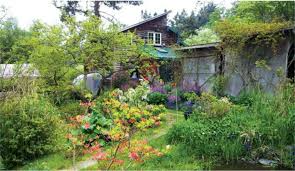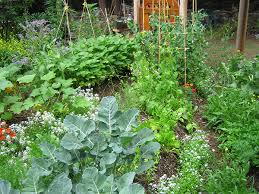Permaculture, a term derived from permanent agriculture” and permanent culture, represents a holistic approach to sustainable living that integrates ecological principles with innovative design.
Developed in the 1970s by Bill Mollison and David Holmgren, permaculture offers a framework for creating self-sustaining ecosystems that harmoniously coexist with nature.
It goes beyond traditional gardening or farming methods by emphasizing the interrelationships between various elements within a system plants, animals, water, soil, and humans.
At its core, permaculture is about observing and mimicking natural systems to create resilient landscapes that provide food, shelter, and energy while reducing waste and resource consumption.
By understanding the principles of permaculture, individuals and communities can cultivate productive environments that support biodiversity and promote ecological health.
These principles include designing for diversity, maximizing edge effects, and valuing renewable resources, which collectively contribute to a more sustainable lifestyle.
The practices of permaculture encompass a wide range of techniques, from regenerative agriculture and agroforestry to water management and soil restoration.
These methods not only enhance food production but also contribute to environmental conservation by improving soil fertility, conserving water, and reducing greenhouse gas emissions.
As global challenges such as climate change, resource depletion, and food insecurity become increasingly pressing, permaculture offers a promising path toward sustainable living.
By embracing permaculture principles and practices, we can create resilient communities that thrive in harmony with nature. This guide will explore the foundational concepts of permaculture and how they can be applied in everyday life to foster a sustainable future for ourselves and the planet.
History and Evolution of Permaculture

Permaculture, a concept rooted in sustainable agricultural practices, has a rich history that traces back to the 1970s. The term itself was coined by Australian ecologist Bill Mollison and his student David Holmgren, who sought to develop a system of agriculture that was not only productive but also sustainable and self-sufficient.
Their work emerged as a response to the growing environmental concerns of the time, including soil degradation, deforestation, and the negative impacts of industrial agriculture.
1. Origins in the 1970s: In 1974, Bill Mollison published the seminal book Permaculture One, co-authored with Holmgren. This book laid the groundwork for permaculture by introducing its principles and emphasizing the importance of designing agricultural systems that mimic natural ecosystems.
Mollison’s background in ecology and agriculture influenced his vision of permaculture as a holistic approach, integrating social, economic, and environmental aspects.
2. Growth and Popularity in the 1980s: The 1980s marked a significant expansion of permaculture ideas. Courses and workshops began to emerge globally, teaching individuals and communities how to implement permaculture principles in their own lives. The Permaculture Institute was established in Australia, providing resources and education for aspiring practitioners.
The movement began to attract attention from environmentalists, farmers, and educators who recognized the potential for permaculture to address food security and ecological challenges.
3. Global Spread in the 1990s: By the 1990s, permaculture had gained international recognition and was being practiced in various countries, including the United States, Canada, Europe, and Asia.
This period saw the development of permaculture design courses (PDCs), which trained individuals in sustainable land management and regenerative practices.
Diverse applications of permaculture emerged, from urban gardening to community farming initiatives.
4. Integration with Social Movements: As permaculture evolved, it began to intersect with other social movements, such as organic farming, regenerative agriculture, and environmental activism.
The principles of permaculture were applied not only to agriculture but also to community development, emphasizing social equity and resilience.
This shift highlighted the importance of creating sustainable communities that prioritize collaboration and shared resources.
5. Modern Developments and Future Directions: In recent years, permaculture has continued to evolve, adapting to new challenges such as climate change, urbanization, and resource depletion. Practitioners are increasingly focusing on integrating technology with traditional permaculture practices to enhance efficiency and sustainability.
The permaculture movement now encompasses a wide range of disciplines, including landscape design, water management, and renewable energy, making it a comprehensive framework for addressing contemporary ecological issues.
Through its history and evolution, permaculture has demonstrated its resilience and adaptability. As we face an increasingly uncertain future, the principles of permaculture offer valuable insights into creating sustainable systems that foster harmony between humans and the environment.
Key Principles of Permaculture Design
Permaculture design is guided by several key principles that promote sustainability and resilience in agricultural systems. These principles include:
1. Observe and Interact: Spend time observing natural ecosystems and human interactions to inform design decisions that work with nature.
2. Catch and Store Energy: Use techniques to capture energy (e.g., solar, wind) and store it for future use, enhancing self-sufficiency.
3. Obtain a Yield: Design systems that produce food, fiber, and other resources to meet human needs while promoting ecological health.
4. Apply Self-Regulation and Accept Feedback: Design systems that can self-regulate and adapt based on feedback, minimizing the need for external inputs.
5. Use and Value Renewable Resources: Prioritize renewable resources over non-renewable ones, fostering sustainable practices that reduce environmental impact.
6. Produce No Waste: Implement systems that minimize waste through recycling, composting, and efficient resource use.
7. Design from Patterns to Details: Start with a broad view of the landscape before diving into specifics, ensuring that designs are holistic and interconnected.
8. Integrate Rather Than Segregate: Promote biodiversity by integrating different species and elements within a system, enhancing resilience and productivity.
9. Use Small and Slow Solutions: Emphasize small-scale, gradual changes that are easier to manage and more sustainable in the long run.
10. Value Diversity: Encourage a diverse range of plants and animals to create a resilient ecosystem that can withstand challenges.
Read Also: 12 Medicinal Health Benefits of Emilia Sonchifolia (lilac tasselflower)
The Ethics of Permaculture

Permaculture is built on three core ethical principles that guide its practices and designs:
1. Care for the Earth: This principle emphasizes the importance of protecting natural ecosystems, maintaining biodiversity, and ensuring sustainable land use.
2. Care for People: Permaculture recognizes the need to meet human needs, fostering community resilience, social equity, and responsible stewardship of resources.
3. Fair Share: This principle advocates for sharing surplus resources and knowledge, promoting equity, and ensuring that all community members have access to essential resources.
Understanding Zones in Permaculture
The concept of zones in permaculture refers to the spatial arrangement of elements within a design to maximize efficiency and productivity. Understanding these zones helps in planning and managing resources effectively. The zones include:
1. Zone 0: This is the home and living area, where daily activities take place. It serves as the central hub for the permaculture design.
2. Zone 1: Closest to the home, this zone includes high-maintenance plants and gardens that require frequent attention, such as kitchen gardens and herb beds.
3. Zone 2: This zone contains larger plantings, like fruit trees and berry bushes, that require less frequent care but are still accessible.
4. Zone 3: Here, more extensive crops, such as grains and legumes, are grown, requiring minimal maintenance once established.
5. Zone 4: This zone is a semi-wild area for foraging, gathering, and some managed resources, such as timber and fodder.
6. Zone 5: The outermost zone represents untouched wilderness, serving as a habitat for wildlife and a space for natural processes to occur.
Soil Health and Permaculture Practices
Healthy soil is the foundation of a successful permaculture garden. It supports plant growth, retains moisture, and fosters beneficial organisms. Here are essential practices to maintain soil health:
1. Composting: Create compost from kitchen scraps, garden waste, and other organic materials. Compost adds nutrients to the soil, improves structure, and enhances microbial activity.
2. Mulching: Apply organic materials like straw, wood chips, or leaves to the soil surface. Mulch reduces evaporation, suppresses weeds, and gradually adds nutrients as it decomposes.
3. Crop Rotation: Change the types of crops grown in specific areas each season. This practice prevents nutrient depletion, reduces pest buildup, and enhances soil fertility.
4. Cover Cropping: Plant cover crops, such as clover or vetch, during the off-season. These crops protect the soil, prevent erosion, and fix nitrogen, enriching the soil for future crops.
5. Minimal Tillage: Reduce soil disturbance by practicing minimal tillage. This preserves soil structure, enhances water retention, and protects beneficial organisms.
Water Management in Permaculture Systems
Effective water management is crucial for maintaining a healthy permaculture garden. Here are key strategies to optimize water use:
1. Rainwater Harvesting: Install rain barrels or cisterns to collect rainwater from roofs. This stored water can be used for irrigation, reducing dependence on municipal sources.
2. Swales and Contour Beds: Create swales shallow, curved ditches along the contour of your land. Swales capture water runoff, allowing it to infiltrate the soil, promoting deep root growth.
3. Drip Irrigation: Use drip irrigation systems to deliver water directly to the roots of plants. This method minimizes water waste and ensures efficient use of resources.
4. Permeable Paths: Design pathways with permeable materials like gravel or mulch. These allow rainwater to seep into the ground rather than running off, helping to recharge groundwater.
5. Native Plants: Incorporate native plants that require less water and are well-adapted to local conditions. They enhance biodiversity and reduce the need for irrigation.
Companion Planting and Plant Guilds
Companion planting is a key strategy in permaculture, where different plants are grown together to enhance growth and deter pests. Here are important concepts to consider:
1. Complementary Relationships: Choose plants that benefit each other. For example, plant tomatoes with basil, as basil repels pests and improves tomato flavor.
2. Pest Deterrence: Use plants that naturally repel pests. Marigolds, for instance, deter nematodes and other harmful insects.
3. Diversity: Create plant guilds—groups of plants that support each other. Include a mix of flowers, herbs, vegetables, and nitrogen-fixing plants to create a diverse ecosystem.
4. Layering: Incorporate different plant heights and root structures. Tall plants provide shade for shorter ones, while deeper-rooted plants access nutrients unavailable to shallow-rooted ones.
5. Attracting Pollinators: Include flowering plants to attract beneficial insects and pollinators. This enhances fruit and seed production in your garden.
Permaculture Techniques for Pest Control
Managing pests is essential for a healthy permaculture garden. Here are effective techniques to control pests sustainably:
1. Integrated Pest Management (IPM): Combine various pest control methods, including biological, cultural, and mechanical strategies, to manage pest populations effectively.
2. Natural Predators: Encourage beneficial insects like ladybugs and lacewings that prey on harmful pests. Create habitats for these beneficial insects by planting diverse flowers.
3. Physical Barriers: Use row covers or netting to physically protect plants from pests. This method is effective in preventing insect damage without chemicals.
4. Homemade Sprays: Create organic sprays using natural ingredients, such as garlic or neem oil, to deter pests. Apply these sprays when pests are first noticed.
5. Monitoring: Regularly inspect your plants for signs of pests or diseases. Early detection allows for quicker intervention and minimizes damage.
Read Also: 13 Medicinal Health Benefits of Arum cylindraceum (tuberous wild calla)
Sustainable Food Production through Permaculture

Permaculture promotes sustainable food production by integrating various elements of agriculture, ecology, and community. Here are key principles that illustrate this approach:
1. Diverse Crop Systems: Cultivating a variety of crops helps improve soil health and resilience. Diversity attracts beneficial insects and reduces the likelihood of pests and diseases.
2. Animal Integration: Incorporating animals into permaculture systems, such as chickens, goats, or ducks, enhances nutrient cycling. Their manure provides valuable fertilizer, while they can help control pests naturally.
3. Perennial Crops: Planting perennial crops like fruit trees or berry bushes reduces soil disturbance and enhances sustainability. These crops require less maintenance and provide food for years.
4. Food Forests: Designing food forests—multi-layered gardens that mimic natural ecosystems—promotes biodiversity and sustainable food production. They include a mix of trees, shrubs, and ground cover plants.
5. Community Involvement: Engaging the community in permaculture practices fosters shared knowledge and resources. Community gardens and cooperative farming initiatives enhance food security and sustainability.
Community and Social Aspects of Permaculture
Permaculture emphasizes community involvement and social aspects of agriculture. Here’s how permaculture contributes to social well-being:
1. Education and Awareness: Permaculture practices educate communities about sustainable agriculture, ecology, and healthy living. Workshops and classes encourage knowledge sharing.
2. Collaboration: Community gardens foster collaboration among residents, promoting social connections and teamwork. Sharing resources and knowledge strengthens community ties.
3. Local Food Systems: By supporting local food production, permaculture reduces reliance on industrial agriculture. This leads to fresher produce and encourages local economies.
4. Resilience Building: Permaculture practices enhance community resilience to environmental and economic challenges. Sustainable food systems improve access to fresh, healthy food.
5. Empowerment: Engaging individuals in permaculture initiatives empowers them to take control of their food sources and promote sustainable practices in their communities.
Challenges and Solutions in Permaculture
While permaculture offers many benefits, it also faces challenges. Here are some common challenges and potential solutions:
1. Initial Setup Costs: Starting a permaculture system can require significant initial investment. Solution: Begin with small-scale projects and gradually expand as resources allow.
2. Knowledge Gaps: Many people lack knowledge about permaculture practices. Solution: Provide educational resources, workshops, and hands-on training to increase awareness and skills.
3. Climate Variability: Climate change can impact the viability of certain crops and practices. Solution: Use resilient crop varieties and adaptive strategies to mitigate climate impacts.
4. Land Access: Limited access to land can hinder permaculture initiatives. Solution: Encourage community gardens, shared spaces, or rooftop gardens to utilize available land creatively.
5. Regulatory Barriers: Local regulations may restrict certain permaculture practices. Solution: Advocate for policy changes that support sustainable practices and educate officials on the benefits of permaculture.
Do you have any questions, suggestions, or contributions? If so, please feel free to use the comment box below to share your thoughts. We also encourage you to kindly share this information with others who might benefit from it. Since we can’t reach everyone at once, we truly appreciate your help in spreading the word. Thank you so much for your support and for sharing!
Read Also: A Child’s Guide to Castle Grayskall Toys: The Perfect Gift for Your Little Knight or Princess

